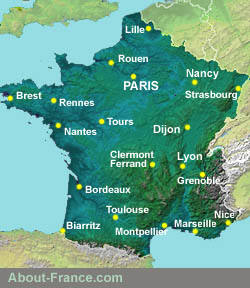- Explore France ►
- KEY PAGES
- Where to go
- How to get there
- Learn about France
French grammar: pronouns
Personal pronouns - les pronoms 1
French
has two more common pronouns than English has; it has both a
singular and plural form of "you", and two forms - masculine and
feminine - corresponding to "they". Otherwise, pronoun usage in French
is fairly straightforward
1. Table of pronouns in French
| English equiv. |
Subject form | Direct object | Indirect object |
Possessive | Emphatic |
| I | Je | me, m' | me, m' | le mien...* | moi |
| (thou) | Tu | te, t' | te, t' | le tien...* | toi |
| he | Il | le, l' | lui | le sien,...* | lui |
| she | Elle | la l' | lui | elle | |
| it | Ce, c' | Forms of il or elle, according to gender | ça | ||
| one | on | – | le sien,...* | – | |
| we | nous | nous | nous | le nôtre...* | nous |
| you | vous | vous | vous | le vôtre...* | vous |
| they (masc) | Ils | les | leur | le leur...* | eux |
| they (fem.) | Elles | les | leur | le leur...* | elles |
* Posessive pronouns agree in number and gender with their referent, i.e. the noun/s to which they refer:
Model: le mien, la mienne, les miens, les miennes
There are a few other pronouns:
se -
the third person singular reflexive object pronoun. See reflexive
pronouns below
en (meaning of it or of them), and
y (normally meaning to or at somewhere). (See y & en)
and the relative pronouns
qui, que, dont and lequel, laquelle etc. for which see relative clauses
en (meaning of it or of them), and
y (normally meaning to or at somewhere). (See y & en)
and the relative pronouns
qui, que, dont and lequel, laquelle etc. for which see relative clauses
2. Notes on using French pronouns
2.0. Subject pronouns replace nouns as the subject of clauses or sentences, as in:- Les enfants chantent > Ils chantent
- La dame s'appelle Mme. Dupont > Elle s'appelle Mme Dupont.
2.1. Direct object pronouns:
2.1.1. Position of the direct object pronoun. When the direct object of a clause is a pronoun, it precedes the verb (including the auxiliary/ies), but does not precede modal auxiliaries. (When the direct object is a noun, it follows the verb).Examples:
That car is following us.
- Cette voiture nous suit.
I've put them back in the kitchen.
Je les ai remis dans la cuisine. (verb form with auxiliary - avoir)
I wanted to see them before they left.
Je voulais les voir avant leur départ. (verb form with modal auxiliary - vouloir)
That car is following us.
- Cette voiture nous suit.
I've put them back in the kitchen.
Je les ai remis dans la cuisine. (verb form with auxiliary - avoir)
I wanted to see them before they left.
Je voulais les voir avant leur départ. (verb form with modal auxiliary - vouloir)
2.1.2. The abbreviated forms m', t', and l' are used before words beginning with a vowel, whether they are used as direct or indirect objects. They are therefore always used - where they exist - when preceding forms of the auxiliary avoir
Examples:
I saw him yesterday. (direct pronoun object)
- Je l'ai vu hier.
He gave me some chocolates. (indirect pronoun object)
Il m'a donné des chocolats.
I saw him yesterday. (direct pronoun object)
- Je l'ai vu hier.
He gave me some chocolates. (indirect pronoun object)
Il m'a donné des chocolats.
2.1.3. Reflexive pronouns. Reflexive pronouns are identical to direct object pronouns, except for the 3rd person singular and plural, for which there is just one single reflexive pronoun, whatever subject it refers back to, and that is se. Reflexive pronouns are used with a small number of reflexive verbs, and generally do not correspond to any pronoun object with equivalent verbs in English. In English, these pronouns are implied, not stated.
Here are twelve of the most common French reflexive verbs: se lever, se coucher, se réveiller, se laver, se taire, s'asseoir, s'appeler, se fâcher, se préparer, se reposer, se taire se tromper.
Examples:
Je me couche maintenant, parce que je me lève à 6h demain. I'm going to bed now, as I'm getting up at 6 tomorrow.
J'ai toujours du mal à me réveiller. I always find it hard to wake up.
Ils se sont lavés avant de se coucher. They washed before going to bed.
Il faut savoir se taire ! You need to know when to say nothing!
Il s'est assis sur une fourmilière! He sat on an anthill.
Je m'appelle Marie. I'm Marie, my name's Marie.
On va se reposer un quart d'heure. We'll have a quarter of an hour's rest.
D'abord ils se sont fâchés, puis ils se sont battus. First they got angry, then they fought.
In most cases, reflexive pronouns correspond to an unstated -self pronoun in English. In some
cases, as in the last example above, ils
se sont battus, they have the meaning of "each other".
So Ils vont se parler
means They're going to talk (to each
other), not They're going
to talk to themselves.Je me couche maintenant, parce que je me lève à 6h demain. I'm going to bed now, as I'm getting up at 6 tomorrow.
J'ai toujours du mal à me réveiller. I always find it hard to wake up.
Ils se sont lavés avant de se coucher. They washed before going to bed.
Il faut savoir se taire ! You need to know when to say nothing!
Il s'est assis sur une fourmilière! He sat on an anthill.
Je m'appelle Marie. I'm Marie, my name's Marie.
On va se reposer un quart d'heure. We'll have a quarter of an hour's rest.
D'abord ils se sont fâchés, puis ils se sont battus. First they got angry, then they fought.
2.2. Indirect object pronouns
2.2.1. Position of the indirect object pronoun. When the indirect object of a clause is a pronoun, it precedes the verb (including the auxiliary/ies), but does not precede modal auxiliaries.Examples:
-
Vous
me devez cent euros.
You owe me 100 Euros-
Il
lui donne toujours un billet gratuit pour ses concerts.
He always gives her/him a free ticket to his concerts. Je
lui ai demandé d'être là pour 17h30. .
I've asked him/her to be there for 5.30 pm.
(verb
form with auxiliary - avoir)
Je
peux leur montrer le chemin.
I
can show them the way. (verb form with modal
auxiliary - pouvoir)2.2.2. Complication ! Word order with double object pronouns.
Clauses with both a direct and an indirect object pronoun.
Normally the indirect pronoun object comes before the direct pronoun object; but when the indirect object is in the third person (i.e. is lui or leur) it comes after the direct object pronoun.
Examples:
- Il me vous
a decrit en grand detail (First person indirect
object - me)
He
described you to me
in great detail -
Mais elle nous l'a dejà dit
(First
person indirect
object - nous)
But
she already told us that !.-
Je
vous l'ai explique très soigneusement . (Second person indirect
object - vous)
I explained it to you very carefully. Je
le
leur ai explique très soigneusement .
(Third
person indirect object - leur)
I
explained it
to them very carefully. Je
peux le lui montrer demain. (Third person indirect
object -
lui)
I
can show it to her tomorrow . 2.3. Possessive pronouns
2.3.1. Unlike English, where the gender of the third person singular possessive pronoun is determined by the gender of the possesser (she > her : he > his), the gender of the possessive pronoun in French is determined by the grammatical gender of the noun to which it refers.Thus, the English sentence "This is his book, and that is hers" would translate litterally into French as:
"Ceci est son livre, et cela est le sien" - which would be completely ambiguous.
Obviously, the litteral translation in this case does not work, and the translator needs to find an alternative solutionn (for example Ceci est son livre à lui, et cela est son livre à elle.)
Occasionally, the possessive pronoun can be qualified by a numeral.
Examples:
Avoiding ambiguity by adding emphatic pronouns:
In this case French needs to find an alternative solution to the possessive pronoun.
Voici
mon velo, et voila le tien.
Here's my
bicycle, and there's yours.Il
a dû vendre sa voiture et la mienne .
He's had to sell his car and
mine.Mon
père a dû vendre sa voiture, et mon
frère a dû vendre les trois siennes.
My father's had to sell his car, and my
brother's had to sell all three of his
J'ai lu votre document Jacques, et
le vôtre, Marie .
I've read your document, Jacques, and
yours Marie.Avoiding ambiguity by adding emphatic pronouns:
Il
a dû vendre son appartement à lui et son
appartement à elle .
He's had
to sell his
flat and hers. In this case French needs to find an alternative solution to the possessive pronoun.
2.4. Emphatic pronouns
2.4.1. Emphatic forms of personal pronouns are used in two circumstances:a) To add emphasis, or to avoid ambiguity (as in the last example above),
b) When the pronoun follows a preposition
Examples:
La France, c'est moi ! Famous saying attributed to king Louis XIV.
He gave it to you, not to them !.
Compare with the simple non-emphatic sentence:
La France, c'est moi ! Famous saying attributed to king Louis XIV.
Quoi?
Lui !!! ???.
What? Him !!! ???. Eux
ils ont dû partir avant la fin .
As for them, they had to leave before the end. Il te
l'a donné à toi, pas à eux !
Indirect
object pronouns
doubled or replaced by emphatic forms. He gave it to you, not to them !.
Compare with the simple non-emphatic sentence:
Il te
l'a donné.
He gave it to you.J'étais
assis entre elle et toi .
I was sitting between her and you.Nous
allons partir avec eux, pas avec lui!
We're going to go with them, not with
him! Venez
avec moi s'il vous plaît .
Come with me please . 2.5. Choosing between il(s) and elle(s)
Il and ils are masculine pronouns, elle and elles are feminine pronouns; but the choice is not always as clear cut as it might appear. The choice will depend on the grammatical gender and number of the noun that the pronoun replaces.Usually this is simple: nouns referring to men and males are masculine, so are referred to using il and ils, nouns referring to women and females are feminine, and are therefore referred to using the pronouns elle and elles.
However, it is vital to remember that it is the grammatical gender of the noun, and not the natural gender of whatever it designates, that determines the choice between il/s and elle/s. Sometimes this causes confusion.
When a plural pronoun refers to a mix of masculine and femine nouns (people), it will always be ils, never elles, even if most of the nouns (people) are feminine.
The most common example of a cause for confusion is the noun personne, which is feminine – une personne. Thus, in grammatically correct French, the pronoun that will take up the noun later in a text or statement should always be elle/s, even if the people being referred to are all males.
As far as inanimate objects are concerned, in order to know which pronoun to use, it is necessary to know the grammatical gender of the noun.
Examples:
I respect this man, he's very wise
Je respecte cet homme; il est très sage.
This lady is very old, she's almost 100.
Cette dame est très vielle; elle a presque cent ans.
I like these apples, they've got plenty of taste.
J'aime ces pommes, elles ont beaucoup de gout .
My drill's broken down, it's not working.
Ma perceuse est en panne, elle ne marche plus.
These people are brave, they've got a lot of courage
Ces personnes sont braves, elles ont beaucoup de courage.
Look, there are Marie, Françoise, Myriam and Arthur; they're coming towards us.
Regardez, il y a Marie, Françoise, Myriam et Arthur, ils viennent vers nous.
I respect this man, he's very wise
Je respecte cet homme; il est très sage.
This lady is very old, she's almost 100.
Cette dame est très vielle; elle a presque cent ans.
I like these apples, they've got plenty of taste.
J'aime ces pommes, elles ont beaucoup de gout .
My drill's broken down, it's not working.
Ma perceuse est en panne, elle ne marche plus.
These people are brave, they've got a lot of courage
Ces personnes sont braves, elles ont beaucoup de courage.
Look, there are Marie, Françoise, Myriam and Arthur; they're coming towards us.
Regardez, il y a Marie, Françoise, Myriam et Arthur, ils viennent vers nous.
Continue to French Pronouns, on - ce
| Return to French grammar pages : index | Study or learn French in France | Essential French words and phrases for travellers |







